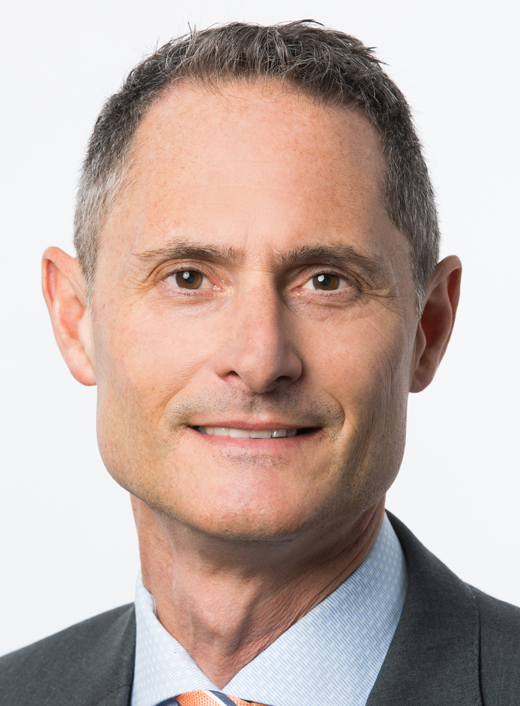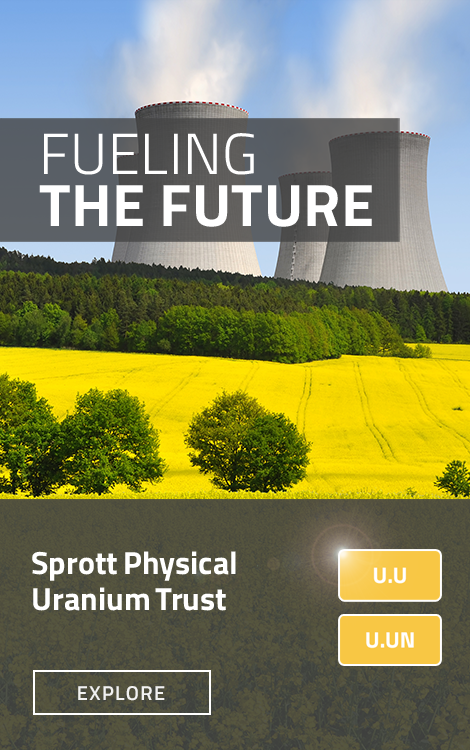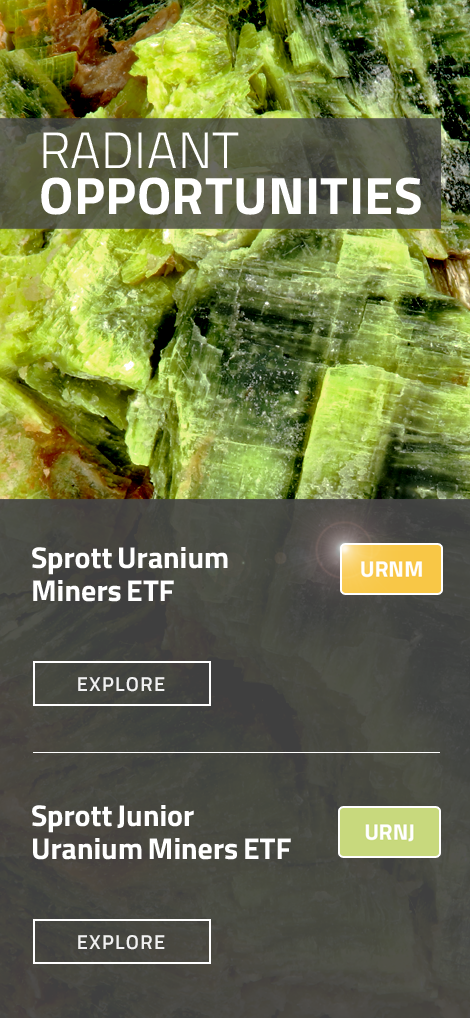November 6, 2023 | (5 mins 41 secs)
John Ciampaglia, CEO of Sprott Asset Management joins CNBC's Fast Money to talk about the uranium market and share Sprott's views on the benefits of nuclear energy and the need for energy security.
Video Transcript
Fast Money’s Melissa Lee: Meantime, uranium prices are trading around 15-year highs and the miners have moved up over the past six months. He believes uranium prices will triple. What time frame are you talking about, John?
John Ciampaglia: Triple? That's a big call. But we've gone up about 150% in the past two years and we think there is more room to go. And the reason for that is quite simple. We have a major supply deficit that is building over the next few years and decades. That's a function of having a lost decade where we did not invest in this technology. As a result, we did not invest in a lot of mining, which is obviously a key part of the story in terms of the fuel for the growing nuclear power fleet worldwide. At the end of the day, the only way to increase production is through higher prices because these are capital-intensive projects with very long lead times, and that capital is starting to come back into the market. We pay close attention to the commodity price because that's the key signal we look for.
Fast Money’s Tim Seymour: John, it's Tim. Thanks for joining us. I share bullishness. I'm long the space. I do think prices will double from here and part of my thesis is that there are people short in the market. I believe there are both producers and some customers. Any thoughts on some of the technical elements of this? Because of some of the lag times in the industry and where, frankly, a lot of liquidity in the spot markets has left us, I think we're as thin as we've been in 15 years. You've heard this from Cameco and you get some sense that one or two of the major producers also may have some deficit.
John Ciampaglia: Yes, it's a very vulnerable supply chain, and it's because it's very concentrated in a few countries and a few companies. And the market right now is very tight. It's very tight in the spot market. But more importantly, the term market is what we look at very closely because that's where utilities are buying uranium under long-term contractual arrangements. If you look at last year, utilities around the globe purchased through long-term contracts about 125 million pounds. That's great. That was the highest amount we had in 10 years. But we're nowhere near our annual replacement rate, which means utilities continue to draw down inventories until they hit about 150 million pounds of annual procurement.
We think we will shoot through the 150 this year, which is a very bullish sign. It means utilities are essentially restocking their inventories of uranium. Why? Because they're feeling very bullish about electricity prices. Government support is shifting back in favor of nuclear power because of decarbonization, energy security and grid reliance. Many people will start to understand that when you add a lot of renewables to your grid, it becomes inherently unstable. You need reliable base-load power, which nuclear power provides, with zero greenhouse gas emissions. It’s a very powerful combination that I think the market is realizing. Suppose we want to fill this supply deficit, as I said. In that case, it comes down to opening new mines, restarting previous mines that have been on care and maintenance for the greater part of the last five or six years, and building new mines is a pretty long timetable for bringing new production to market.
Fast Money’s Melissa Lee: To be clear, John, when you talk about a deficit, do you mean the current market including Russian uranium? Because if the U.S. and Europe actually sanctioned Russian uranium, what would that then do to the market? And do you ever see that as a possibility, as geopolitics continue not to get better?
John Ciampaglia: I'll break that down into two parts. If you add up all of the mines around the world, we think we'll get to about 150 pounds of annual production in the next 12 months. The annual requirements for the 434 reactors is 180 million pounds. We're already operating with a 30-million pound annual deficit. If you look at the World Nuclear Association, it expects the annual requirements in 2040 to be almost 300 million pounds annually. We're talking about a serious increase in production that will have to be filled if we want to build all the nuclear capacity that the world endeavors to.
Russia, specifically, is not a big producer of uranium, but it is a key player in the nuclear fuel cycle around U3O8 conversion to UF6, which is a gasification process and the enrichment of uranium where It controls about 40% of the global capacity. This obviously has Western utilities and governments concerned, and right now, there is a very strong effort to reshore some of these steps in the fuel cycle back to friendly countries. You have utilities in the U.S. and France that are currently growing their capacity so that we're less reliant on Russia. There are no sanctions on Russia right now on anything having to do with uranium or nuclear fuel. And it's for the simple reason that we do not have the capacity in the West to cut them off. It's a matter of time before sanctions come into place. The current bills floating around the House are envisioning 2028. But between now and then, we're still going to be relying in some part on Russia for the fuel cycle.
Fast Money’s Melissa Lee: John, thank you. Nice speaking with you.
Important Disclosures & Definitions
An investor should consider the investment objectives, risks, charges, and expenses of each fund carefully before investing. To obtain a fund’s Prospectus, which contains this and other information, contact your financial professional, call 1.888.622.1813 or visit SprottETFs.com. Read the Prospectus carefully before investing.
Exchange Traded Funds (ETFs) are considered to have continuous liquidity because they allow for an individual to trade throughout the day, which may indicate higher transaction costs and result in higher taxes when fund shares are held in a taxable account.
The funds are non-diversified and can invest a greater portion of assets in securities of individual issuers, particularly those in the natural resources and/or precious metals industry, which may experience greater price volatility. Relative to other sectors, natural resources and precious metals investments have higher headline risk and are more sensitive to changes in economic data, political or regulatory events, and underlying commodity price fluctuations. Risks related to extraction, storage and liquidity should also be considered.
Shares are not individually redeemable. Investors buy and sell shares of the funds on a secondary market. Only market makers or “authorized participants” may trade directly with the fund, typically in blocks of 10,000 shares.
The Sprott Silver Miners & Physical Silver ETF is new and has limited operating history.
Sprott Asset Management USA, Inc. is the Investment Adviser to the Sprott ETFs. ALPS Distributors, Inc. is the Distributor for the Sprott ETFs and is a registered broker-dealer and FINRA Member. ALPS Distributors, Inc. is not affiliated with Sprott Asset Management USA, Inc.



